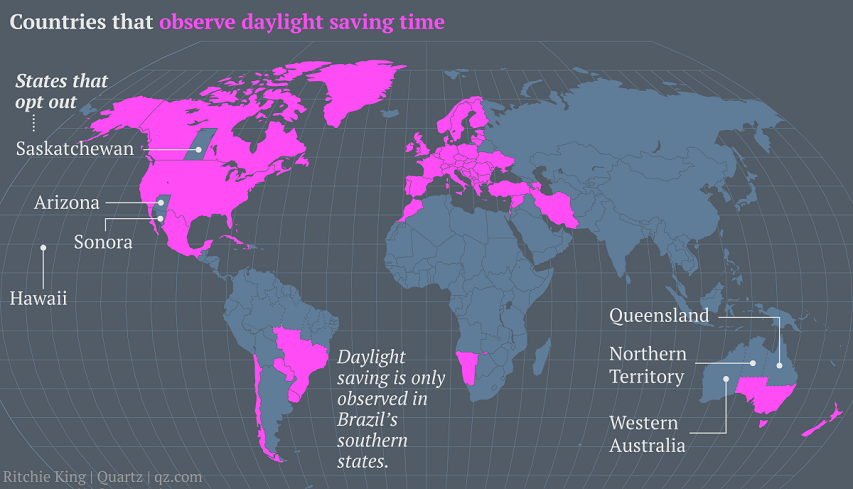H/T to AEI for the link.
September 7, 2015
July 31, 2015
Rapido’s Real Train Car Restoration: 1
Published on 21 Jul 2015
The guys at Rapido Trains bought a full-size Pullman sleeping car and are in completely over their heads.
March 4, 2015
How many colours do you see?

On LinkedIn, Professor Diana Derval posted this image with an explanation why different people will see significantly different numbers of colours:
You see less than 20 color nuances: you are a dichromats, like dogs, which means you have 2 types of cones only. You are likely to wear black, beige, and blue. 25% of the population is dichromat.
You see between 20 and 32 color nuances: you are a trichromat, you have 3 types of cones (in the purple/blue, green and red area). You enjoy different colors as you can appreciate them. 50% of the population is trichromat.
You see between 33 and 39 colors: you are a tetrachromat, like bees, and have 4 types of cones (in the purple/blue, green, red plus yellow area). You are irritated by yellow, so this color will be nowhere to be found in your wardrobe. 25% of the population is tetrachromat.
You see more than 39 color nuances: come on, you are making up things! there are only 39 different colors in the test and probably only 35 are properly translated by your computer screen anyway 🙂
It is highly probable that people who have an additional 4th cone do not get tricked by blue/black or white/gold dresses, no matter the background light 😉
H/T to ESR for the link.
May 18, 2014
Arena football as methadone for the NFL-addicted fan
Dave Rappoccio went to his first arena football game. It didn’t make him decide to give up the NFL:
Last Sunday thanks to a generous fellow I obtained a free ticket to go see an AFL game. The Portland Thunder vs the Arizona Rattlers at the Moda center in PDX. It was my first ever Arena Football game. I’d never watched it (outside the occasional highlight) so I didn’t know what to expect at all. What I got was what I would describe as Football lite. Actually no, it wasn’t football lite, football lite is preseason football.
Arena Football is Football Lite lime. Lite beer is already bland, watered down and generally disappointing but no one is drinking it for the taste. You know it’s going to taste like crap. You drink it for the slight buzz to feel slightly better about yourself. Now we have Football lite lime. It’s the same crap, you know it’s going to taste like crap, but you think to yourself…well, maybe it’ll provide a slightly different type of experience. That lime might turn crappy piss football into somewhat tasty crappy piss football. So you try it. And it tastes basically exactly the same. That’s Arena Football.
[…]
Despite the weird goalposts, the 7 on 7, and everything else, it really just does feel like generic minor league football. It’s not a high enough level of play to enthrall you like the NFL, but it’s not quite wacky enough like Canadian Football to differentiate itself either. It more or less just felt like watching an NFL team do a full contact practice. I would have personally preferred more wackiness. I saw an interception off the bouncy screens, followed by a botched snap on a kick, and I got excited. This was going to be great. Then it settled into basic football and I spent most of the game mocking it along with the people I was with. The players are competent enough to get things done, but not quite exceptional to really impress you. It’s just alright. It was a good way to fill 3 hours, in many ways it was still football and fun to see football again, but it’s not going to leave a lasting impact. I was more emotionally invested in trying to get a T-shirt launched towards me from the cheerleaders than watching the game.
November 2, 2013
It’s “time” for a change
In Quartz, Allison Schrager wonders why we still bother with daylight savings time and four separate timezones for continental US states:
This year, Americans on Eastern Standard Time should set their clocks back one hour (like normal), Americans on Central and Rocky Mountain time do nothing, and Americans on Pacific time should set their clocks forward one hour. After that we won’t change our clocks again — no more daylight saving. This will result in just two time zones for the continental United States. The east and west coasts will only be one hour apart. Anyone who lives on one coast and does business with the other can imagine the uncountable benefits of living in a two-time-zone nation (excluding Alaska and Hawaii).
It sounds radical, but it really isn’t. The purpose of uniform time measures is coordination. How we measure time has always evolved with the needs of commerce. According to Time and Date, a Norwegian newsletter dedicated to time zone information, America started using four time zones in 1883. Before that, each city had its own time standard based on its calculation of apparent solar time (when the sun is directly over-head at noon) using sundials. That led to more than 300 different American time zones. This made operations very difficult for the telegraph and burgeoning railroad industry. Railroads operated with 100 different time zones before America moved to four, which was consistent with Britain’s push for a global time standard. The following year, at the International Meridian Conference, it was decided that the entire world could coordinate time keeping based on the British Prime Meridian (except for France, which claimed the Prime Median ran through Paris until 1911). There are now 24 (or 25, depending on your existential view of the international date line) time zones, each taking about 15 degrees of longitude.
Now the world has evolved further — we are even more integrated and mobile, suggesting we’d benefit from fewer, more stable time zones. Why stick with a system designed for commerce in 1883? In reality, America already functions on fewer than four time zones. I spent the last three years commuting between New York and Austin, living on both Eastern and Central time. I found that in Austin, everyone did things at the same times they do them in New York, despite the difference in time zone. People got to work at 8am instead of 9am, restaurants were packed at 6pm instead of 7pm, and even the TV schedule was an hour earlier. But for the last three years I lived in a state of constant confusion, I rarely knew the time and was perpetually an hour late or early. And for what purpose? If everyone functions an hour earlier anyway, in part to coordinate with other parts of the country, the different time zones lose meaning and are reduced to an arbitrary inconvenience. Research based on time use surveys found Americans’ schedules are determined by television more than daylight. That suggests in effect, Americans already live on two time zones.
H/T to Tyler Cowen for the link.
October 29, 2013
Colby Cosh on IQ
In his latest Maclean’s column, Colby Cosh talks about the odd evolutionary advantages that accrue as you get further from the equator:
A new study in the biometric journal Intelligence presents surprising data from Japan that reveal that IQ, imputed from standardized tests given to a large random sample of Japanese 14-year-olds, varies strongly and persistently with latitude. The Japanese are usually thought of — even by themselves — as being quite homogenous ethnically; the myth of the sturdy, super-cohesive “Yamato race” has not yet been entirely obtruded out of existence. But it turns out that the mean IQs of students in Japanese prefectures apparently vary from north to south by two-thirds of a standard deviation — a spread almost as large as the “race gaps” in cognitive performance which trouble education scholars in multicultural countries like ours. Sun-drenched Okinawans, as a group, do not test as well as the snowbound citizens of Akita.
It is an article of liberal faith that IQ is a bogus tool cooked up by white supremacists to justify imperialism and slavery. I am happy to nod along, but the monsters who developed IQ tests certainly never planned on creating strife between the two ends of Honshu Island. Kenya Kura’s study demonstrates the usual statistical connections between IQ and social outcomes, including physical height, income, and divorce and homicide rates. IQ may be a phony racist artifact, but if shoe size predicted life success as well as those stupid little logic puzzles do, every middle-class parent you know would have one of those Brannock foot-measuring thingies mounted proudly on the wall. That is why IQ persists in the top drawer of the psychometrics toolbox.
August 30, 2013
A profitable way to deal with annoying calls
At the BBC News website, Joe Kent profiles today’s hero in the ongoing battle against annoying telephone solicitations:
A man targeted by marketing companies is making money from cold calls with his own higher-rate phone number.
In November 2011 Lee Beaumont paid £10 plus VAT to set up his personal 0871 line — so to call him now costs 10p, from which he receives 7p.
The Leeds businessman told BBC Radio 4’s You and Yours programme that the line had so far made £300.
Phone Pay Plus, which regulates premium numbers, said it strongly discouraged people from adopting the idea.
Mr Beaumont came up with the plan when he grew sick of calls offering to help him reclaim payment protection insurance (PPI), or install solar panels.
He said: “I don’t use my normal Leeds number for anyone but my friends and family.”
Once he had set up the 0871 line, every time a bank, gas or electricity supplier asked him for his details online, he submitted it as his contact number.
He added he was “very honest” and the companies did ask why he had a such a number.
He told the programme he replied: “Because I’m getting annoyed with PPI phone calls when I’m trying to watch Coronation Street so I’d rather make 10p a minute.”
He said almost all of the companies he dealt with were happy to use it and if they refused he asked them to email.
August 26, 2013
A small note from the hand tool trade
In a discussion of the plight of Sears in the major appliance market, Coyote Blog mentions an earlier Sears mis-step in a different market:
Oddly, I witnessed a similar Sears private label fracas when I worked for Emerson Electric over a decade ago. For years and years, Emerson (not the folks who make the cheap radios and TVs) manufactured many of the Sears Craftsman hand tools and power tools. Sears got tough one year, and negotiated a better deal of some sort with someone else, and an entire division of Emerson saw its sales basically going to zero. So Emerson bought a bunch of orange paint and plastic, went to Home Depot, and cut a deal for a private label tool line at Home Depot (Emerson separately owns the Rigid tool company, so a lot of the items were branded Rigid). Emerson ended up in potentially better shape (I did not stay long enough to see how it turned out), partnered with a growing rather than a declining franchise.
March 9, 2013
What if physical objects had DRM?
From TechHive:
In many cases, DRM can be get kind of silly, and it can completely shape the way you use the digital media you purchase. DRM might make you think twice about how many devices you can still add your iTunes Library to, or which computer will get a shiny new version of image editing software.
Luckily there’s no DRM on any physical objects like a cup paired to one person’s mouth. That is, there wasn’t until a group of hackers put together a chair that self-destructs after eight uses.
February 13, 2013
Can we get versions of this for the Toronto Star and National Post?
February 1, 2013
Want a house on the moon? Let’s just 3D print that out for you…
I’ve always wanted a house on the moon:
Architects Fosters and Partners have revealed designs for a building on the Moon that could be constructed from material already on its surface.
An inflatable structure would be transported from Earth, then covered with a shell built by 3D printers.
The printers, operated by robots, would use soil from the Moon, known as regolith, to build the layered cover.
The proposed site for the building is the southern pole of the Moon.
It is designed to house four people and could be extended, the firm said.
In 2010 a team of researchers from Washington State University found that artificial regolith containing silicon, aluminium, calcium, iron and magnesium oxide could be used by 3D printers to create solid objects.
January 7, 2013
“Wow, a zeppelin!”
Okay, maybe not a Zeppelin(TM), but still:
The first rigid airship to be built since the 1930s is about to commence trials in California: and the Pelican prototype also features a new technology, never yet flown, which could finally change things for lighter-than-air craft and see the leviathans of the skies make a serious comeback at last.
The 230ft-long, 18-ton demonstrator has been built for the US military by radical airship firm Aeros of California, helmed by Ukrainian LTA visionary Igor Pasternak. Aviation Week reports that it has now tested its ground manoeuvring equipment inside its hangar, and that next week the ship is set to actually lift off in a further sequence of tests for the Pentagon.
In particular, the US military wants to see if the Pelican can defeat the great bugbear of airships: the fact that they cannot usually offload cargo or passengers without taking on equivalent amounts of ballast. This is because, as weight is removed, the ship will become massively buoyant and will surge upwards uncontrollably.
December 28, 2012
You’ve all seen marching bands, but have you ever seen a dancing orchestra?
Movement and Music: University of Maryland Symphony Orchestra’s Prelude to the Afternoon of a Faun.
H/T to Paul Wells for the link.
November 21, 2012
The Hall of Technical Documentation Weirdness returns
Darren Barefoot has revived the Hall of Technical Documentation Weirdness as a Pinterest site:
November 17, 2012
Steve Landsburg says paying off the national debt would be a bad idea
Here’s an interesting argument:
How high should taxes be? High enough to cover expected outlays going forward — but no higher.
That’s because any additional revenue would be used to pay down the federal debt, which is a bad idea. It was almost surely a mistake to run up this much debt in the first place, but now that we’ve got it, the best thing to do is to keep it forever.
Here’s why:
Every $100 in outstanding debt commits the government to making payments with a present value of $100, and hence to collecting tax revenues with a present value of $100. In a world where the interest rate is 3%, the options include collecting (and paying off) $100 immediately, or $50 this year and $51.50 next year, or $11.38 a year for ten years running, or $3 a year forever. Because deadweight loss (i.e. the economic damage due to the disincentive effects of taxes) is roughly proportional to the square of the tax rate, it turns out that the latter — the policy of paying interest forever without ever making a principal payment — is (at least roughly) the policy that minimizes the present value of deadweight loss.







